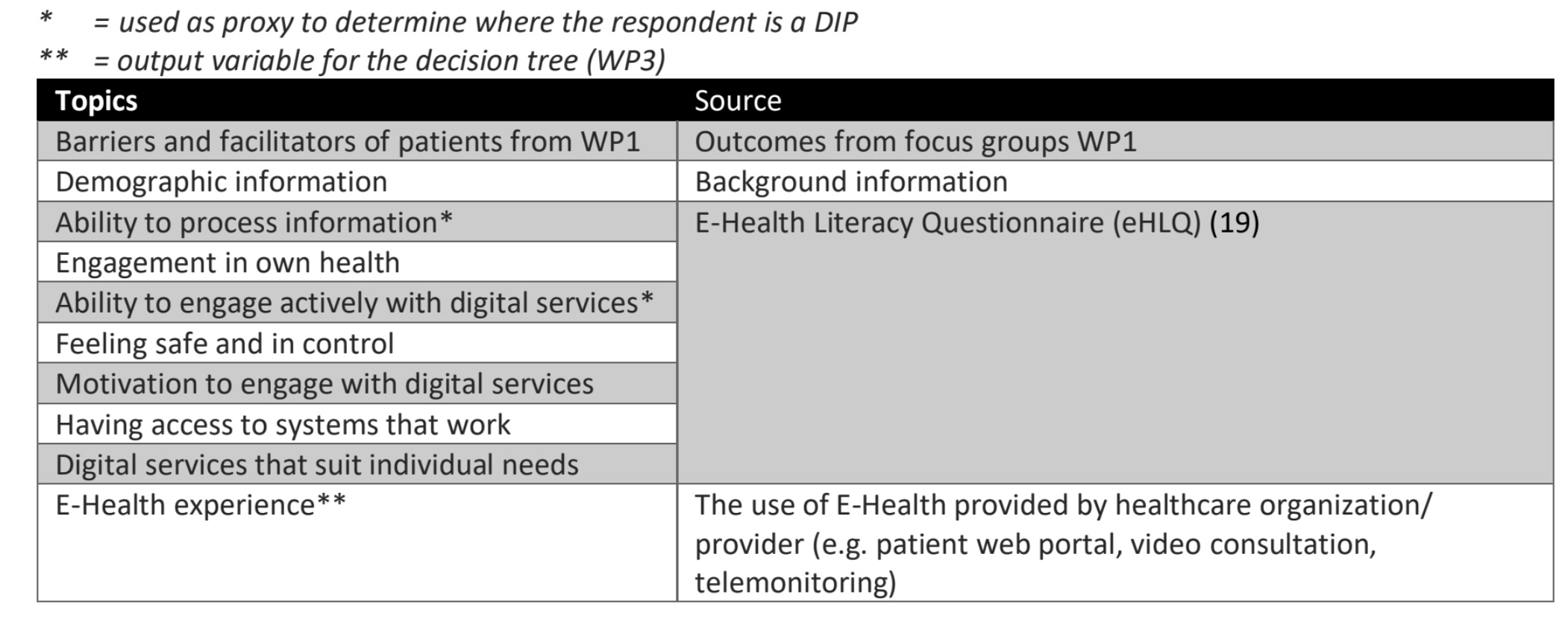Method
Research plan
I include Chronic Obstructive Pulmonary Disease (COPD) patients, a common chronic condition. There are many E-Health applications available for this group, but E-Health user rates are low due to the high proportion of DIPs, which makes this an excellent case group for this study. COPD patients are on average older (67±11 years and have a low education level. I want to perform my study in the Netherlands, Germany and in the UK to compare cultural aspects of E-Health and to improve the generalizability of my findings.
WP1: How are contextual and communicational factors related to E-Health usage in DIPs?
Opinions and needs regarding conceptual and communicative experiences will be discussed with COPD patients in focus groups (Netherlands, UK and Germany, table 2). Qualitative research aims to collect experiences, attitudes and opinions and data collection stops if saturation is reached: a power calculation is not applicable. I expect to reach saturation with 2 focus groups in each country. I will hire an assistant in the UK and Germany. WP1 will lead to an overview of contextual and communication experience factors for DIPs.

WP2: Is there a difference between DIPs who use E-Health and DIPs not using E-Health?
Based on the results of the WP1 a survey is developed and added to the E-Health Literacy Framework concepts (eHLQ, table 3) to collect factors related to E-Health use. Based on other paper survey studies in COPD the expected response rate is 50%. At least 250 respondents are needed (see WP3). I expect that 75% of the respondents is a DIP (table 1) and only these will be included in this study. Therefore, the paper survey will be sent to 333 COPD patients in each country (n=1000 total). WP2 will lead to a large dataset with factors that are related to E-Health use in DIPs.

WP3a: How do interactions between factors from WP2 predict the likelihood of E-Health use in DIPs?
WP3b: Which clusters can be distinguished based on the different pathways in the decision tree?
Data from WP2 will be used to develop a tree that will predict the likelihood of a DIP to use E-Health. I will use the Classification and regression trees (CART) technique, comparable with the technique I used previously (30). CART datasets need between 250-500 cases, I aim at including 375 patients. The tree provides a visual overview of (previously unknown) interactions between factors. Above that, it shows different clusters of DIPs (Figure 3).

WP4 What are, according to DIPs and healthcare professionals, feasible and effective strategies to make E-Health accessible for each cluster?
In cocreation with DIPs and healthcare professionals (Netherlands, Germany and UK), I will develop strategies for each cluster to overcome barriers. I will perform interviews with COPD patients (30 E-Health users and 30 non-users) and 6 focus groups with COPD healthcare professionals. I will hire an assistant in Germany and in the UK.
I will spend 3 months in Germany and in the UK. This leads to a clear and concise overview of strategies per cluster that can be used by healthcare organisation to engage DIPs in E-Health. WP5 Are the strategies developed in WP4 feasible to use and to implement in healthcare? Healthcare professionals ( Dutch hospital) will test the decision support method to engage digital illiterate COPD patients in their E-Health program. I will evaluate: 1) proportion of DIPs that start using E-Health (<2 months), and 2) satisfaction of professionals with this procedure.
This part of the study will provide first insights in the feasibility and effectiveness of the decision support tool.

